Exegesis of Mark 3:20-35
Mark 3:20-35 (NASB)
20 And He came home, and the crowd gathered again, to such an extent that they could not even eat a meal.
21 When His own people heard of this, they went out to take custody of Him; for they were saying, “He has lost His senses.”
22 The scribes who came down from Jerusalem were saying, “He is possessed by Beelzebul,” and “He casts out the demons by the ruler of the demons.”
23 And He called them to Himself and began speaking to them in parables, “How can Satan cast out Satan?
24 “If a kingdom is divided against itself, that kingdom cannot stand.
25 “If a house is divided against itself, that house will not be able to stand.
26 “If Satan has risen up against himself and is divided, he cannot stand, but he is finished!
27 “But no one can enter the strong man’s house and plunder his property unless he first binds the strong man, and then he will plunder his house.
28 “Truly I say to you, all sins shall be forgiven the sons of men, and whatever blasphemies they utter;
29 but whoever blasphemes against the Holy Spirit never has forgiveness, but is guilty of an eternal sin”—
30 because they were saying, “He has an unclean spirit.”
31 Then His mother and His brothers arrived, and standing outside they sent word to Him and called Him.
32 A crowd was sitting around Him, and they said to Him, “Behold, Your mother and Your brothers are outside looking for You.”
33 Answering them, He said, “Who are My mother and My brothers?”
34 Looking about at those who were sitting around Him, He said, “Behold My mother and My brothers!
35 “For whoever does the will of God, he is My brother and sister and mother.”
Historical Background of Mark’s Gospel
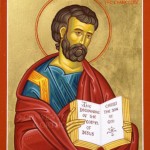
Date and Authorship
The date of the composition of Mark is typically understood to be between 50 to 70 CE.[1] Mark was believed to be a traveling companion of Paul, called John Mark. This was according to the historian Eusebius who referenced Papias as the source for the information.[2] Papias was a late 1st and early 2nd century church leader who was thought to have been an apostle of John.[3] The gospel texts that make up Mark is believed to have a large oral circulation before it was written down and incorporated into the gospel text.[4]
Audience
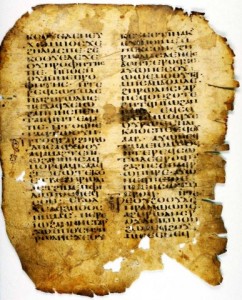
Some believe the audience of Mark to be Roman based on the idea that John Mark is the author and that the date of authorship intersected with the same date range where John Mark visited Paul in Rome, as well as similarities in Mark’s gospel to Paul’s letter to Rome.
Others have noted the relationship of John Mark and Peter to account for his Roman location of writing. This means that the date of authorship at about the same time as the Roman persecutions by Nero 62-68CE.[5] In addition, Clement of Alexandria indicated that Peter approved it to be read in the churches in the regions of Italy.[6] This also accounts for the large amount of Latinism found within the texts, such as Caesar, census, denarius, flagellare, grabatus, and quite a few more including Latin idioms.[7]
Purpose for writing
NT scholar David DeSilva suggests that even though the location of writing may have been Rome and that certainly influenced the text, it should not be viewed solely as a gospel to the Roman people but to a wider audience including many of the churches in the circum-Mediterranean area.[8] From internal evidence it appears that Mark is addressing (as a pastor) those who are already Christians and are dealing with the onset of persecution. He writes to remind them that Jesus is returning and that God is in control.[9] Moreover, the Kingdom of God (not Rome) is the kingdom that will prevail.
Basic Outline of Mark (focus passage expanded Mark 3:20-35)
- Introduction: “The Beginning” (1:1–15)
- Jesus’ Public Ministry (1:16–8:26)
- Jesus’ Authority (1:16–3:12)
- Jesus’ Teaching (3:13–6:6)
- The Twelve Chosen (3:13-19)
- Jesus Confronted at Home (3:20-35)
- Jesus Returns Home to Family (3:20-21)
- Jesus Accused by Religious Leaders (3:22)
- Jesus Defends Himself (3:23-29)
- Accusation Reiterated (3:30)
- Jesus Speaks on True Family (3:33-35)[10]
- Jesus and Mission (6:7–8:26)
- Jesus’ Death (8:27–16:8)
- Jesus’ Instruction of the Disciples (8:27–10:52)
- Jesus Confronts Jerusalem (11:1–13:37)
- Jesus’ Death and Resurrection (14:1–16:8)[11]
Literary Context of Mark 3:20-35
Form/Structure of Passage
Mark uses many literary forms throughout the gospel. The selected passage for this exegesis is structured in a chiasm, with Jesus’ words to the scribes as being the focus of the structure. Mark 3:20-35 chiastic form is shown below.
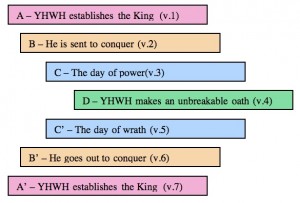
a. Jesus returns home to his family (3:20)
b. His family pursues him (3:21)
c. Jesus accused by the scribes (3:22)
d. Jesus defends himself (3:23–29)
c´. Scribes’ accusation reiterated (3:30)
b´. Jesus’ family still pursuing him (3:31-32)
a´. Jesus declares who his real family is (3:33–35)
NT scholars, Puskas and Crump, point out that Mark routinely brackets or sandwiches blocks. They list Mark 3:20-35 as a bracketed passage.[12] Stephen Barton also includes it as a self-contained unit and mentions that it is part of Mark’s interweaving different sections of Christology and Discipleship.[13]
Context and Location within the Gospel of Mark
In the context of the surrounding passages, Mark 3:10-34 appears to be acting as a segue between a narrative block on Jesus’ ministry/authority and the preceding section, which is a teaching block about those who hear the word and bear fruit. The previous events in the gospel narrative are Jesus’ healing and being questioned on the Sabbath. Ultimately those verses are about Jesus’ authority being challenged, which happens on each occasion (2:23-3:12). Mark 3:20 appears to be the culmination of him being challenged. Even his own people are out to get him (3:21, 31-32). Jesus then refocuses on those who are his true family; the ones who do the will of God (3:33-35). This leads into the next block which is teaching about the seed that fell on different grounds, another reference to those who had rejected his words and ministry (4:1-34).
However, most outlines of the book of Mark seem to differ on how to deal with this section and how it is be located within the gospel. Robert Guelich (a NT professor at Fuller Seminary) attaches it to the start of the teaching section (4:1-4:34).[14] Puskas and Crump also place the entire passage with the proceeding passage about the sewer parable.[15] James A. Brooks (NT Greek scholar) does something completely different and dissects the passage into three parts and lists the last part about Jesus’ family with the first one, which is also about his family. He then lists Jesus’ accusation as the last part.[16]
Genre
The genre of Marks gospel has been compared to Graeco-Roman biographies, but R. T. France (NT scolar) suggests that Mark’s gospel should not be held to a strict genre or pattern. Even within the genre of Graeco-Roman biography many variations exist.[17] Edwards (Theology professor at Whitworth) and France both agree that Mark seems to have his own genre, specifically that of a gospel. It seems that Mark did not write according to a specific guidelines with the purpose to create a work within that genre, but rather, he wrote to share and preserve the good news, as he was able to best interpret.[18]
Verse By Verse Exegesis
And He came home, and the crowd gathered again, to such an extent that they could not even eat a meal (3:20).
The first sentence in this passage has a few features that should be noted. First, the English translation from the NASB and NRSV both indicate that he (Jesus) came home. Later Greek manuscripts have changed ἔρχεται to the plural form, to indicate that they came home; referring to the disciples.[19] This is because within this same sentence it says that they were crowded so much that they could not eat. [20] Thus, the first sentence is either a victim of bad grammar or the real reading was either totally plural or totally singular in reference to the use of its pronouns.
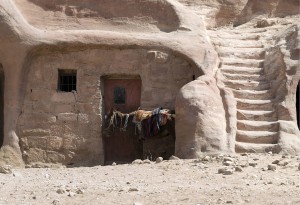
Secondly, the phrase “He came home,” in the Greek text does not indicate if he came to a house or if he came (to) home (Καὶ ἔρχεται εἰς οἶκον).[21] In Mark 2:1 there is a similar scene where Jesus comes home and a crowd gathers, but the phrase that is used is (ἐν οἴκῳ ἐστίν), “He is staying at (a) home.” Neither verse indicates that the house belongs to a certain person. But in 1:29 when Jesus visits the house of Simon and Andrew, the text actually uses the genitive case for Simon and Andrew, indicating that the house is of Simon and Andrew (εἰς τὴν οἰκίαν Σίμωνος καὶ Ἀνδρέο). The same is true for the house of Simon the Leper in 14:3. The location of Jesus’ home typically thought to be in Capernaum since Mark 2:1 records that when Jesus returned to Capernaum it was heard that he was at home. In addition, the language of 2:1 and 3:20 of how the crowds gathered (again) seems to indicate that Jesus coming home to Capernaum and drawing a large crowd is normal or at least expected.[22] Therefore, the rendering as “he came home” seems to fit the best for Mark 3:20. When he go to other people’s homes Mark tells who’s house it is. He did not merely come to the home or house of someone, but simply came home.
Lastly, the comment by Mark that the crowd gathered in such a way that they could not eat has two significant markers. First that it happened again and secondly that it was so severe that Jesus and those with him could not even eat a meal; something that is echoed in 6:31 when Jesus and the disciples had to escape to a boat to catch a breather. The inclusion of this phrase could perhaps provide an explanation for why his own people went out to take custody of him in 3:21.
When His own people heard of this, they went out to take custody of Him; for they were saying, “He has lost His senses.” (3:21)
The phrase that “His own people heard he had come home” is a bit confusing since “His own people” is a rather ambiguous expression. Who are Jesus’ people? Is this an idiom for his family since they are the subject later in this passage? The Greek phrase οἱ παρʼ αὐτοῦ (the ones near/by/with/alongside of him) seems to indicate that it was the disciples who were his own people and went out to take custody of Jesus.[23] However, that translation would make little sense since the disciples were already with him. In addition, it is his family that finally arrives in 3:31 and are standing outside of the house seeking him. Thus, the most logical translation seems to be that “those who are near him (Jesus)” is a reference to his family or kinsmen. This is further supported by other Greek texts that use this phrase to mean the same thing, such as Proverbs 31:21 in the LXX, and Susanna 33 (the 13th chapter of the Greek version of Daniel).[24]
The idea that they were coming to get him because he had “lost his senses,” as the NASB words it, may also be used to indicate one is beside themselves or out of their mind.[25] Given that his family was not present but “had heard” of Jesus’ current state of being, it is possible that their concern may have been artificially heightened. The occurrence of Jesus being surrounded by crowds at home seems to be commonplace. So, why is it in 3:21 that they think he is out of his mind?
Possibly because the last time he was home (2:1) he was doing something similar and ended up having a nasty confrontation with the scribes and religious leaders. In addition, Mark indicated in 3:6 that the religious leaders were now conspiring to destroy him. So, it seems in this light that the fact that his family is worried for him is understandable. France notes that it is possible that the family was a bit concerned about their own reputation, as well as Jesus’.[26]
The scribes who came down from Jerusalem were saying, “He is possessed by Beelzebul,” and “He casts out the demons by the ruler of the demons.” (3:22)
In verse 22 the focus now shifts to what seems to be the reason why his family is concerned; namely the scribes from Jerusalem. The accusation drawn against Jesus is not that he is blaspheming as in Mark 2:7, or breaking Jewish customs as in 2:16, or even  breaking the Sabbath as in 2:23-3:12, but that Jesus was able to perform his miraculous deeds by the power of Beelzebul. One of the standout features of this sentence is that the scribes were from Jerusalem. No longer was it just local scribes who were after Jesus but now Jerusalem scribes, of a much higher rank, are after Jesus.[27]
breaking the Sabbath as in 2:23-3:12, but that Jesus was able to perform his miraculous deeds by the power of Beelzebul. One of the standout features of this sentence is that the scribes were from Jerusalem. No longer was it just local scribes who were after Jesus but now Jerusalem scribes, of a much higher rank, are after Jesus.[27]
The reader also notices that this is the scribe’s first attempt to accuse Jesus of something other than breaking Jewish law. This tactic may have been employed because evidence of his miracle workings has already been so widespread and witnessed, even by the religious leaders, that a new tactic had to be put in place to discredit Jesus.[28] The fact that he was not complying with the scribal laws did not seem to keep people from flocking to him.
Another thing worth noting is that the scribes accuse Jesus of casting out demons; something that happened in previous events, but not indicated to be happening at the present time. It seems as though word about his previous ministry had reached Jerusalem and it was evident that the scribes from Jerusalem were aware that part of his ministry of casting out demons. Not only that but Jesus had commonly been going through local synagogues and casting out demons (1:39).
And He called them to Himself and began speaking to them in parables, “How can Satan cast out Satan? (3:23)
The fact that Mark does not indicate who Jesus “called to himself” makes it a hard sentence to read. Was he teaching the disciples again or was he correcting the scribes? Mark adds a summary in 3:30 saying that Jesus’ response was “because they were saying ‘He has an unclean spirit.’” In light of this connection it would seem to be the scribes who Jesus was talking to. Moreover, the scribes were described previously has talking about Jesus, not necessarily talking to Jesus (3:22). So, if Jesus was going to have words with them he would have had to call them over to him. Matthew 12:25-29 and Luke 11:17-22 seem to reword this scene and correct the ambiguity by saying that Jesus knew that they were talking about him and he responded directly to them (the scribes).
An interesting feature of Jesus’ response is that when he reframes the accusation of being possessed by Beelzebul, or having Beelzebul (ὅτι Βεελζεβοὺλ ἔχει), he does not reference Beelzebul, but rather Satan. Some have suggest that Jesus’ response is a matter of getting right to the point without beating around the bush, of demonic theories. Whereas Beelzebul has been generally regarded as the Lord of the demons, Satan is the end all of demonic leadership.[29] In addition, Jesus’ ramping up of terminologies, preceded by the following logical impossibility of Satan casting out Satan, is set up almost as a mockery of the accusation.[30] Many contend that Beelzebul is just another name for Satan even though it never occurs in Jewish literature.[31]
“If a kingdom is divided against itself, that kingdom cannot stand. If a house is divided against itself, that house will not be able to stand. If Satan has risen up against himself and is divided, he cannot stand, but he is finished! (3:24-26).
Jesus now provides the answer to his own rhetorical question, “how can Satan cast out Satan?” The response is in a doublet or possibly triplet format. Jesus’ response has been listed as a form of doublet by Puskas and Crump, but the parallel ideas and words in the three ifs (subject, divided, cannot stand) seem to indicate a three level parallelism.[32][33] However, the last line has some differences. In the first two the subject that is divided is a dwelling or inanimate object (kingdom, house) and in the last it is Satan, a being. In addition, the last statement adds “he is finished!” to the end which either indicated that it is separate from the previous doublet or it is the final consequence of the triplet explanation. In addition, Guelich points out that the last sentence uses a different “if,” (εἰ) rather than the subjective version (ἐὰν). Thus, the two first statements move from hypothetical to conditional.[34] But whether it’s a triplet or a doublet, Mark shows Jesus not just opposing the idea but completely obliterating the notion.
But no one can enter the strong man’s house and plunder his property unless he first binds the strong man, and then he will plunder his house. (3:27)
After completely repudiating the idea that he is working by the power of Satan, Jesus beings to speak in parable fashion about the house of the strong man. The reference to the strong man’s house is likely a play on words since Beelzebul can be read as Lord of  the house/temple/abode and a few other variants. Given the previous mention of the divided house and now this mention of the strong man’s house, it seems that a play on words is being employed.[35] James Edwards suggests that the reference reaches back to some well-known messianic prophecies in the Testament of Levi, from the Pseudepigraph. The same reference to the strong man can be found in the Psalm of Solomon 5:3, also in the Pseudepigraph. He also supposes that Isaiah 49:24-26 could be a biblical parallel, but the passage from Isaiah seems less clear about how it relates to messianic expectations.[36]
the house/temple/abode and a few other variants. Given the previous mention of the divided house and now this mention of the strong man’s house, it seems that a play on words is being employed.[35] James Edwards suggests that the reference reaches back to some well-known messianic prophecies in the Testament of Levi, from the Pseudepigraph. The same reference to the strong man can be found in the Psalm of Solomon 5:3, also in the Pseudepigraph. He also supposes that Isaiah 49:24-26 could be a biblical parallel, but the passage from Isaiah seems less clear about how it relates to messianic expectations.[36]
Regardless of the history behind Jesus’ reference, it appears that it is directly related to Jesus’ mission of manifesting the kingdom of God which binds the strong man and is evidenced by the work that is being done by Jesus. In fact, Jesus’ casting out of evil spirits is a clear sign that he is stronger than Satan.[37] It is interesting that before this passage the only other reference to Satan has been in 1:12-13 and it about the Holy Spirit initiating confrontation with Satan. The binding up of the strong man by the power of the Holy Spirit is an important idea because the very next thing that Jesus says is an indictment of those who blaspheme against the Spirit.
Truly I say to you, all sins shall be forgiven the sons of men, and whatever blasphemies they utter; but whoever blasphemes against the Holy Spirit never has forgiveness, but is guilty of an eternal sin.” (3:28-29)
These verses are some of most notable of the entire New Testament. Jesus begins by his familiar amen I say (Ἀμὴν λέγω), indicating a serious admonition to the audience. These two verses also contain a number of Hebreic elements which can be easily translated backwards into Hebrew, which Edwards suggests that it means the early church was careful to preserve the transmission of Jesus’ sayings.[38] Given the severity of these two verses, a careful transmission of them seems likely. This admonition is also recorded in the other two synoptic gospels (Matt 12:31, Luke 12:10).
He next states a simple gospel truth, that all sins and blasphemes of man will be forgiven. But that is followed by a double warning for those who blaspheme against the Holy Spirit. With the scribes knowing full well that the casting out of demons is a sign of the kingdom and the working of the Spirit of God, they have blasphemed the Spirit of God by claiming the casting out of demons was by the power of Beelzebul.[39] This particular sin of blaspheming the Holy Spirit came with the ultimate judgment, eternal sin.
This stern warning about the eternal sin should be read only in context of what was currently taking place with the trained religious leaders and Marks gospel introduction, where John the Baptist announces that one is coming that will baptize with the Holy Spirit (Mark 1:8).[40] William Lane points out that Jesus’ admonition was targeted specifically at the scribes who were trained legal specialists whose task was to interpret the Law to the people. Given their specialization and responsibility Jesus’ warning of eternal sin seems well fit.[41] This is further evidenced by the editorial comment that Mark included in the very next verse.
The reader of this passage should be aware that a general application of this warning by Jesus can be dangerous. Taking this passage out of its context provides many problems for the interpreter and can even seem to be in opposition to the gospel message itself!
What this passage is not saying is that if someone accidentally blasphemes Jesus in the wrong way they will be banned from heaven or will not able to obtain salvation. The best scripture verse to help explain Jesus’ words is in Hebrews 6.
For it is impossible for those who were once enlightened, and have tasted the heavenly gift, and have become partakers of the Holy Spirit, 5 and have tasted the good word of God and the powers of the age to come, 6 if they fall away, to renew them again to repentance, since they crucify again for themselves the Son of God, and put Him to an open shame. (Hebrews 6:4-6)
Those who witnessed the miracles and wonders of Jesus’ ministry yet still chose to accuse Jesus of casting out demons by the prince of demons surely will have no place in God’s plan of salvation. For they have seen and tasted the heavenly gift but rather than accepting it they blasphemed it.
–because they were saying, “He has an unclean spirit.”(3:30)
This simple comment in the text assures the reader that Jesus’ harsh words were a response to the scribe’s accusations, and helps to connect their actions of accusing his work of the Holy Spirit with the stern warning given.[42]
Then His mother and His brothers arrived, and standing outside they sent word to Him and called Him. A crowd was sitting around Him, and they said to Him, “Behold, Your mother and Your brothers are outside looking for You.” (3:31-32)
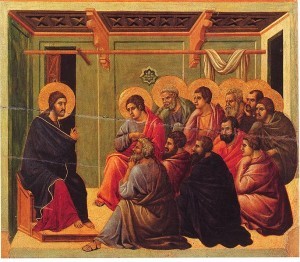
Beginning in verses 31-32 the focus is shifted to the last part of this sandwiched passage. Those who were seeking to take Jesus into custody in verse 21 have now arrived and are standing outside of the crowd, which has surrounded the house or at the very least surrounded Jesus (3:32). The fact that Joseph is not listed as a member of this family is interesting and a likely indicator that Joseph had passed on by this time.[43] This verse also brings about a very serious division in theology which is how to interpret the fact that along with his mother, his brothers also arrive. Those who contend that Jesus has no physical siblings suggest that they are step siblings, cousins, or perhaps that the word us being used in a larger sense. However, there is nothing within the text here or elsewhere that suggests a general term is being used or that they were nothing less than Mary’s blood sons. This is further evidenced by their mention by name in Mark 6:3.[44] It is even further evidenced by the crowd’s acceptance and knowledge that Jesus’ brothers and mother were now present and looking for Jesus, which they communicated to him in verse 32.
Answering them, He said, “Who are My mother and My brothers?” Looking about at those who were sitting around Him, He said, “Behold My mother and My brothers! For whoever does the will of God, he is My brother and sister and mother.” (3:33-35)
In a surprise response, Jesus seemingly rejects his own family. William Hendriksen suggests that Jesus’ response may be better understood as one of inclusiveness and not exclusion. He is not rejecting his family as much as opening his kinship to all who do the will of the father.[45] One cannot help but consider whether or not his response about true family was due to the episode with the scribes and their opposition to the will of God and his kingdom.
Theological Message
This passage has a lot of powerful concepts but the core of the message focuses on a line drawn in the sand. On one side of that line are those who response to the gospel and wok of the Holy Spirit and do the will of God. On the other side are those, like the scribes, who reject the work of Christ, even in the midst of witnessing him perform all the signs of the kingdom and the Holy Spirit. The gospel’s movement next into the next passage about the parable of the sewer highlights the emphasis on people’s reactions to Jesus’ ministry and the eternal consequence that follows. I would also suggest that it should be paralleled with Hebrews 6:4-6.
What a great message to those who crowded around Jesus that day; that they, not the scribes, would be honored in the kingdom of God. Moreover, this passage provides a portrait of grace. Jesus’ affirmation of those who do the will of God (no matter what their background or relation is) is a powerful one. Including one as a family member was a high privilege in the clan structure societies. You clan relationship decided one’s status, identity, and ability to survive. Jesus crossed all cultural boundaries by opening his arms to all people. What a great message to those who crowded around Jesus that day; that they, not the scribes, would be honored in the kingdom of God.
Today Christians should be overjoyed to know that Jesus warmly welcomes those who obey the will of the father, no matter what blasphemies and sins they have committed. No reservation should be held. As the crowd in Capernaum did, they should approach the Lord with confidence and sit at his feet. Young, old, black, white, male, female, sinner and righteous, all are graphed into the family of Jesus if they are willing to do the will of the father.
Footnotes
[1] Charles B. Puskas and David Crump, An Introduction to the Gospels and Acts (Grand Rapids: Eerdmans, 2008), 86.
[2] Paul J. Achtemeier, “Mark, Gospel of” In The Anchor Yale Bible Dictionary, ed. David Noel Freedman (New York: Doubleday, 1992), 4:542.
[3] William R. Schoedel, “Papias (Person)” In, The Anchor Yale Bible Dictionary, ed. David Noel Freedman (New York: Doubleday, 1992), 5:140.
[4] Werner H. Kelber, “Mark an Oral Tradition,” In Semeia 16 (Missoula: Society of Biblical Literature, 1979), 9.
[5] James A. Brooks, “Mark,” In The New American Commentary (Nashville: Broadman & Holman Publishers, 1992), 28.
[6] Robert A. Geulich, “Mark 1-8:26,” In The World Biblical Commentary (Dallas: World Books Publisher, 1989), Page xxix.
[7] Adam Winn, The Purpose of Mark’s Gospel: An Early Christian Response to Roman Imperial Propaganda (Wissenschaftliche Untersuchungen zun Neuen Testament, 2. Reihe, 2008), 81.
[8] David A. DeSilva, An Introduction to the New Testament (Downers Grove: InterVarisity Press, 2004), 197.
[9] Robert A. Guelich, Page xliii.
[10] NOTE: Outline in red is done by Justin Holmes.
[11] Robert A. Guelich, xxxvii.
[12] Charles B Puskas and David Crump, 74.
[13] Stephen C. Barton, The Cambridge Companion To The Gospels, (Cambridge: Cambridge University Press, 2006), 147-148.
[14] Robert A. Guelich, xxxvii.
[15] Charles B Puskas and David Crump, 84.
[16] James A. Brooks, Mark, 33.
[17] R. T. France, “The Gospel of Mark,” In The New International Greek Testament Commentary (Grand Rapids, MI; Carlisle: W.B. Eerdmans; Paternoster Press, 2002), 6.
[18] James R. Edwards, “The Gospel According to Mark,” In The Pillar New Testament Commentary (Grand Rapids, MI; Leicester, England: Eerdmans; Apollos, 2002), 24-25.
[19] Bruce Manning Metzger and United Bible Societies, A Textual Commentary on the Greek New Testament, Second Edition a Companion Volume to the United Bible Societies’ Greek New Testament (London; New York: United Bible Societies, 1994), 70.
[20] R. T. France, 164.
[21] Michael W. Holmes, The Greek New Testament: SBL Edition, (The Society of Biblical Literature, Logos Bible Software Edition, 2011), Mark 3:20.
[22] R. T. France, 164.
[23] Henry Barclay Swete, “The Gospel According to St. Mark. The Greek Text With Introduction, Notes and Indices,” In Classic Commentaries on the Greek New Testament (London; New York: MacMillan and co.; The MacMillan Company, 1898), 63.
[24] R. T. France, 166.
[25] William Arndt, Frederick W. Danker and Walter Bauer, A Greek-English Lexicon of the New Testament and Other Early Christian Literature, 3rd ed. (Chicago: University of Chicago Press, 2000), 350.
[26] R. T. France, 167.
[27] James A. Brooks, 75.
[28] Henry Swete, 64.
[29] Henry Swete, 65.
[30] James A Brooks, 75.
[31] James R. Edwards, 120.
[32] Charles B Puskas and David Crump, 74.
[33] James R Edwards, 121.
[34] Robert A. Guelich, 176.
[35] Theodore J. Lewis, “Beelzebul” In, The Anchor Yale Bible Dictionary, ed. David Noel Freedman (New York: Doubleday, 1992), 1:639.
[36] James R. Edwards, 121.
[37] William Lane, “The Gospel according to Mark,” In The New International Commentary on the New Testament, (Grand Rapids: Wm. B. Eerdmans Publishing Co, 1974), 143.
[38] James R. Edwards, 122.
[39] William Lane, 145.
[40] Edward R. James, 123.
[41] William Lane. 146.
[42] Robert A. Guelich, 180.
[43] Ibid, 181.
[44] Ibid 181.
[45] William Hendriksen and Simon J. Kistemaker, In Exposition of the Gospel According to Mark, New Testament Commentary (Grand Rapids: Baker Book House, 2001), 142.
Bibliography
(Just about all of these resources can be found in my store if you click the link in the site menu for store)
Achtemeier, Paul J. “Mark, Gospel of.” In The Anchor Yale Bible Dictionary, ed. David Noel Freedman, Vol 4. New York: Doubleday, 1992.
Arndt, William; Danker Frederick W. and Bauer, Walter. A Greek-English Lexicon of the New Testament and Other Early Christian Literature, 3rd ed. Chicago: University of Chicago Press, 2000.
Barton, Stephen C. The Cambridge Companion To The Gospels. Cambridge: Cambridge University Press, 2006.
Brooks, James A. “Mark.” In The New American Commentary. Nashville: Broadman & Holman Publishers, 1992.
DeSilva, David A. An Introduction to the New Testament. Downers Grove: InterVarisity Press, 2004
Edwards, James R. “The Gospel According to Mark.” In The Pillar New Testament Commentary. Grand Rapids, MI; Leicester, England: Eerdmans; Apollos, 2002.
France, R. T. “The Gospel of Mark.” In The New International Greek Testament Commentary. Grand Rapids, MI; Carlisle: W.B. Eerdmans; Paternoster Press, 2002.
Geulich, Robert A. “Mark 1-8:26.” In The World Biblical Commentary. Dallas: World Books Publisher, 1989.
Holmes, Michael W. The Greek New Testament: SBL Edition. The Society of Biblical Literature, Logos Bible Software Edition, 2011.
Hendriksen William and Kistemaker, Simon J. “Exposition of the Gospel According to Mark,” In New Testament Commentary. Grand Rapids: Baker Book House, 1953-2001.
Kelber, Werner H. “Mark an Oral Tradition. In Semeia 16. Missoula: Society of Biblical Literature, 1979.
Lane, William “The Gospel according to Mark.” In The New International Commentary on the New Testament. Grand Rapids: Wm. B. Eerdmans Publishing Co, 1974.
Lewis, Theodore J. “Beelzebul” In, The Anchor Yale Bible Dictionary, ed. David Noel Freedman, Vol 1. New York: Doubleday, 1992.
Metzger Bruce Manning and United Bible Societies, A Textual Commentary on the Greek New Testament, Second Edition a Companion Volume to the United Bible Societies’ Greek New Testament. London; New York: United Bible Societies, 1994.
Puskas, Charles B. and Crump, David. An Introduction to the Gospels and Acts. Grand Rapids: Eerdmans, 2008.
Schoedel, William R. “Papias (Person).” In The Anchor Yale Bible Dictionary, ed. David Noel Freedman, Vol 5. New York: Doubleday, 1992.
Swete, Henry Barclay “The Gospel According to St. Mark. The Greek Text With Introduction, Notes and Indices,” In Classic Commentaries on the Greek New Testament. London; New York: MacMillan and co.; The MacMillan Company, 1898.
Winn, Adam. The Purpose of Mark’s Gospel: An Early Christian Response to Roman Imperial Propaganda. Wissenschaftliche Untersuchungen zun Neuen Testament, 2. Reihe, 2008.

How can someone know whether or not they are guilty of this eternal sin? In the past I had some unwanted blasphemous thoughts. I have repented and I trust in Christ but I am not sure if I am guilty of this sin or not.
Ryan, in simple terms, unless you witnessed Jesus perform a miracle by means of the Spirit of God, and then rejected that as being from God, then you have not committed the unforgivable sin. This sin was very situational and that historical situation is now gone. You have nothing to fear my friend.